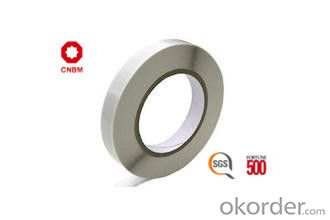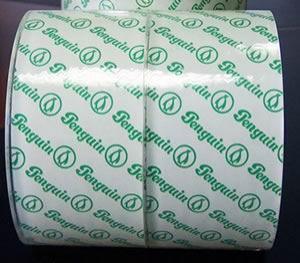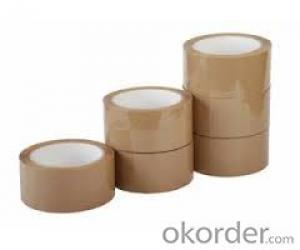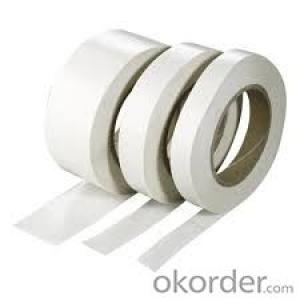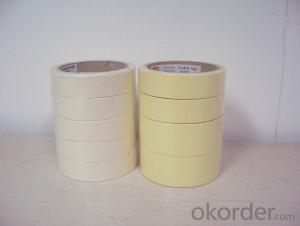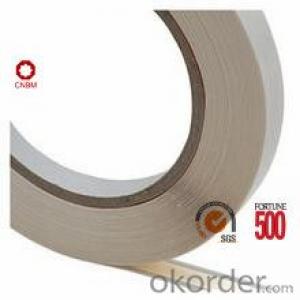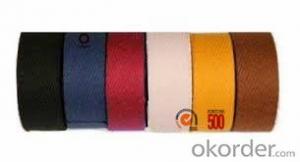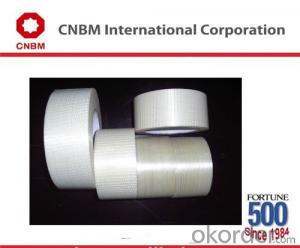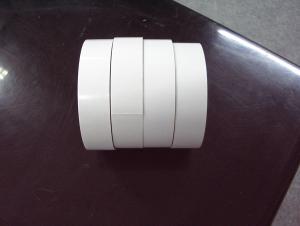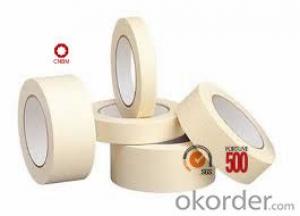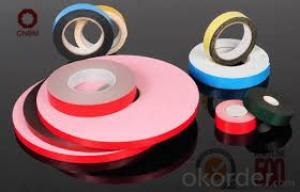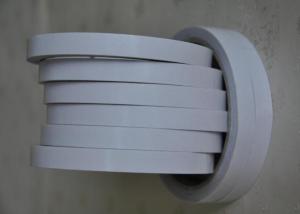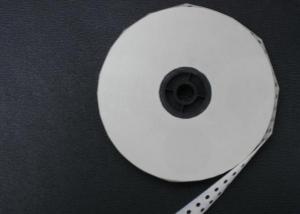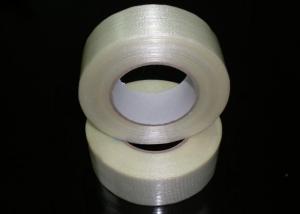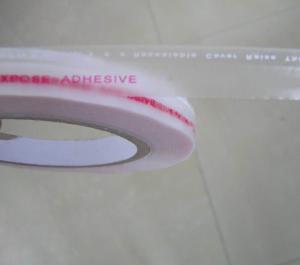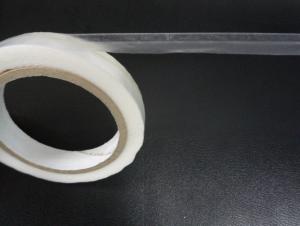Tamperproof Double Sided Tissue Tape 100 Micron SGS & ISO9001
- Loading Port:
- Shanghai
- Payment Terms:
- TT OR LC
- Min Order Qty:
- 10000 m²
- Supply Capability:
- 20000000 m²/month
OKorder Service Pledge
OKorder Financial Service
You Might Also Like
Specifications
·World Top 500 Enterprises
·Resistance to cold, heat and aging
·Best quality and competitive price
·SGS&ISO9001
Typical Physical Reports of Double Sided Tissue Tape

Description
The Double Sided Tissue Tape is of tissue as the carrier, coating with hot melt adhesive, water based acrylic, solvent based acrylic. It is excellent in flame retardant, high temperature stability, and anti-aging. It provides well insulation to various products.
The thickness of the tape can be customized.
Application
General purpose of Double Sided Tissue Tape: widely used for bonding, fixing for leather, foam, sponge, garment, shoe, luggage, plastic, paper splicing and stationery.
Packaging & Delivery
Packaging Detail:
Log Roll: Length 1000mm; width: 1050mm, 1260mm, 1040mm..
Cut Roll: As per customer’s requirements
Delivery Detail: within 7-15 working days after receiving your deposit
Service
Sample of Double Sided Tissue Tape is available.
Your inquiry will be replied within 12 hours.
24 hours service
Well-trained & experienced sales representative are ready to answer you.

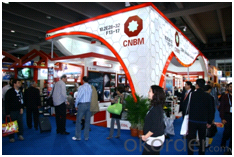
About us
CNBM International Corporation (CNBM International) is a state-owned company and we have sound business relations with clients from over 120 countries. Currently, we have wholly-owned overseas subsidiaries and branches in 5 countries with a view to realize localization, which also represents an essential progress in our globalization target. We have over twenty years experiences.
Welcome to contact us and visit the factory!
- Q: Is packaging tape easy to tear by hand?
- Yes, packaging tape is generally easy to tear by hand. Most packaging tapes are designed with a serrated edge or perforation, making it easy to tear off a desired length without the need for scissors or any other tools. This feature allows for quick and convenient packaging and sealing of boxes or packages without any hassle. However, it is important to note that the ease of tearing may vary depending on the brand and quality of the packaging tape.
- Q: Can packaging tape be used for sealing arts and crafts materials?
- Yes, packaging tape can be used for sealing arts and crafts materials. It provides a strong and secure bond, making it suitable for various types of materials such as paper, cardboard, and plastic. However, it is important to consider the aesthetics and longevity of the tape, as there may be more specialized options available for specific art and craft projects.
- Q: Can packaging tape be used for sealing paper bags?
- Indeed, paper bags can be securely sealed with packaging tape. Possessing robust adhesive properties, packaging tape effectively adheres to diverse surfaces, including paper. When appropriately applied, it furnishes a dependable and safeguarding seal for paper bags, effectively shielding their contents from spillage or external influences. To optimize adhesion, it is crucial to ascertain that the surface of the paper bag is both clean and dry prior to tape application.
- Q: Can packaging tape be used for sealing plastic storage jars?
- Yes, packaging tape can be used for sealing plastic storage jars. Packaging tape is designed to provide a strong and secure seal, making it suitable for various applications including sealing plastic storage jars. It can effectively keep the contents of the jar protected and prevent any leakage or contamination. However, it is worth noting that there are other options specifically designed for sealing jars, such as jar lids and seals, which may provide a more secure and airtight seal.
- Q: Can packaging tape be used for sealing packages with heavy items?
- Yes, packaging tape can be used for sealing packages with heavy items. However, it is important to ensure that the tape is strong and durable enough to withstand the weight and provide proper sealing. It is recommended to use heavy-duty packaging tape specifically designed for sealing heavy packages to ensure secure packaging.
- Q: Can packaging tape be used for sealing plastic storage baskets?
- Yes, packaging tape can be used for sealing plastic storage baskets. Packaging tape is designed to be strong and adhesive, making it suitable for securing and sealing various types of materials, including plastic. By using packaging tape, you can effectively seal the openings or seams of plastic storage baskets, keeping the contents secure and protected. However, it is important to note that the longevity and effectiveness of the seal may depend on the quality and durability of the specific packaging tape used. Additionally, it is recommended to clean and dry the surface of the plastic storage baskets before applying the tape to ensure proper adhesion.
- Q: What are the alternatives to packaging tape for sealing packages?
- There are several alternatives to packaging tape for sealing packages. Here are a few options: 1. Gummed tape: Gummed tape, also known as water-activated tape, is a popular alternative. It is made of paper or reinforced material and requires water to activate the adhesive. Gummed tape forms a strong bond with the package and provides a tamper-evident seal. 2. Strapping: Strapping is commonly used for securing heavy or bulky packages. It involves using plastic or metal straps to hold the package tightly together. Strapping can be more secure than tape, especially for larger or irregularly shaped items. 3. Shrink wrap: Shrink wrap is a plastic film that can be wrapped around the package and sealed using heat. As the film shrinks, it tightly conforms to the shape of the package, providing a secure seal. Shrink wrap is commonly used for wrapping pallets or bundling multiple items together. 4. Adhesive labels: Adhesive labels can be used as an alternative to tape for sealing packages. These labels have a strong adhesive backing that sticks to the package, providing a secure seal. They are especially useful for small or lightweight items. 5. Twine or string: For lighter packages, twine or string can be used to secure the contents. Simply wrap the string around the package multiple times and tie it securely. While this method may not be as strong as tape, it can be a cost-effective and eco-friendly option. Ultimately, the choice of alternative to packaging tape depends on the size, weight, and nature of the package. Each option has its own advantages and disadvantages, so it's important to consider the specific requirements of the shipment before making a decision.
- Q: What are the benefits of using transparent packaging tape?
- The benefits of using transparent packaging tape include clear visibility of the contents of the package, easy identification of any tampering or damage, professional appearance, and the tape's durability and strength for securing packages effectively.
- Q: Can packaging tape be used for sealing plastic toys?
- Yes, packaging tape can be used for sealing plastic toys. It provides a strong adhesive bond and helps keep the toy's packaging secure.
- Q: What are the considerations for using packaging tape on glossy surfaces?
- When using packaging tape on glossy surfaces, there are a few important considerations to keep in mind. Firstly, the adhesion of the tape may be affected by the smoothness and slickness of the glossy surface. The glossy finish can create a barrier that makes it challenging for the tape to stick securely. Therefore, it is crucial to ensure that the surface is clean and free from any dirt, oils, or residue that could hinder the tape's adhesion. Additionally, the type of packaging tape used is important. Opting for a tape specifically designed for glossy surfaces, such as high tack or acrylic adhesive tapes, can provide better adhesion and longevity. These tapes are formulated to adhere well to smooth surfaces and offer stronger bonds compared to regular packaging tape. It is also advisable to test the tape on a small, inconspicuous area of the glossy surface before applying it extensively. This will allow you to gauge the tape's adhesion and ensure that it does not leave any residue or damage the glossy finish when removed. Furthermore, the temperature and environmental conditions should be considered. Extreme heat or cold can impact the performance of the tape on glossy surfaces. For instance, high temperatures can cause the adhesive to soften, leading to tape failure, while cold temperatures may make the tape more brittle and prone to peeling. Lastly, it is essential to handle the glossy surface with care to avoid fingerprints, smudges, or scratches that may diminish its appearance. Wearing gloves or using protective films can help prevent such issues. By considering these factors, you can increase the effectiveness and reliability of packaging tape on glossy surfaces, ensuring that your packages are securely sealed without compromising the aesthetic appeal of the glossy finish.
Send your message to us
Tamperproof Double Sided Tissue Tape 100 Micron SGS & ISO9001
- Loading Port:
- Shanghai
- Payment Terms:
- TT OR LC
- Min Order Qty:
- 10000 m²
- Supply Capability:
- 20000000 m²/month
OKorder Service Pledge
OKorder Financial Service
Similar products
Hot products
Hot Searches
Related keywords




